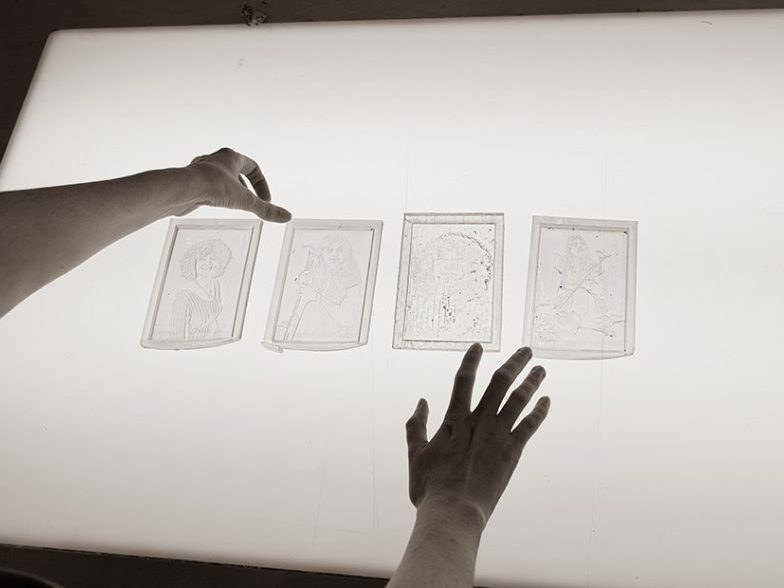Constructing the ABCs
of arts advocacy
Nontraditional student Sarah Vojnovich is using her personal experience to help museums improve accessibility, belonging and community
Written By: Meg Whalen
Photos By: Amy Hart
The first sound Sarah Vojnovich remembers hearing was the lap of her dog’s tongue in his water bowl. She was 10 years old and had just received a cochlear implant. Suddenly, the world resounded.
American Sign Language was Vojnovich’s first language. Having been diagnosed at 18 months with profound sensorineural hearing loss, she spent the next nine years learning to sign, read lips and even speak before the cochlear implant brought a cascade of new tones and timbres into her right ear. It would be another nine years before her left ear received the same awakening.
Drawn to visual art — and especially photography — as a child, Vojnovich won art contests in elementary school. She got her first camera, a pink Nikon COOLPIX, at age 13.
“It was my favorite thing ever,” she said.
With a communications degree from Wingate University, a paralegal certificate from UNC Chapel Hill and an associate degree in advertising and graphic design from Wake Tech Community College, Vojnovich has returned to that early love and will earn a Bachelor of Fine Arts in Photography (with a minor in art history and a certificate in entrepreneurship) in December 2024. But her accomplishments as a student at UNC Charlotte extend far beyond refining her skills behind the lens. She is becoming an ardent advocate for accessibility in the world of visual arts.
Advocating art access

“Without access, there is no belonging; without belonging, there is no community.”
Sarah Vojnovich creates 3-D prints of her 2-D photographs for visitors of all abilities to experience them.
In the summer of 2022, Vojnovich had an internship at The Mint Museum where she helped conduct an audit of the museum’s operations, programming and facilities. The lack of resources at the museum for people with low to no vision prompted her to pursue the issue, and the following semester she completed an independent study, evaluating accessibility resources for both vision- and hearing-impaired visitors at three museums: the North Carolina Museum of Art, the Smithsonian Museum of American Art and the Metropolitan Museum of Art.
“As a person with hearing loss, I believe in access for everyone. Accessibility in art is still a problem, especially for people with low to no vision,” she said.
Last summer, Vojnovich experienced “a dream come true” when she was hired for an internship offered jointly by the Smithsonian Institution, the National Parks Service and the Institute for Human-Centered Design. Among her tasks were designing exhibition layouts that would accommodate visitors in wheelchairs; creating in-person, hybrid and fully remote versions of instructional courses for museum docents to train them on ADA compliance and other diversity, equity and inclusion topics; and updating and designing new tactile map icons to be used in indoor and outdoor settings.
While the Smithsonian Institution is considered a national leader in museum accessibility, “the standards just haven’t caught up with how people are living and experiencing things now,” said Michelle Cook, the Smithsonian’s inclusive design specialist. Cook supervised Vojnovich and said the work she did during her internship was invaluable.
“She was an absolute joy and treasure and asset in our office. It was a phenomenal experience for us both.” To work in inclusive design, Cook added, “you have to have a profound amount of empathy for the human experience and for experiences that are not your own.”
Seeing with your hands

In particular, Vojnovich enjoyed her creative work on tactile map icons, which involved updating existing icons and Braille lettering, designing new identifiers for locations previously unrepresented (such as lactation rooms or family bathrooms) and testing all of her suggested designs with an expert-user focus group to determine preferences. The ultimate goal, she said, is for sighted maps and tactile maps, which are currently separate items, to be integrated into comprehensive maps that can serve everyone.
Cook said that Vojnovich’s efforts “will contribute to the field for years to come.” Recommendations and resources that the Smithsonian develops are available at no cost to the public.
“Our hope is that any arts or exhibitions organization will apply this to their work,” Cook said. “And the intention is to have the guidelines adopted into policy.”
Vojnovich is already putting her beliefs into practice as she prepares for her senior thesis exhibition project. In addition to the photographs that she will produce for the BFA exhibition in December, she is developing tactile versions of those images, which she will 3-D print and display alongside the 2-D photographs for visitors to experience with their hands. Vojnovich hopes that her work will inspire greater inclusivity in future exhibitions both on campus and off.
"Without access, there is no belonging; without belonging, there is no community,” she said. “How are we supposed to move forward as a society if we constantly exclude?”
Meg Whalen is director of communications for the College of Arts + Architecture.